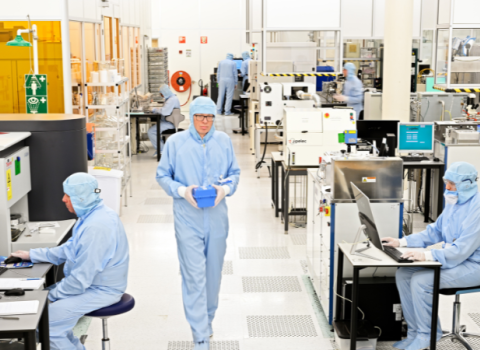
In the case of Polaris’ early stage investment in T2 Biosystems Inc., a Cambridge, MA startup out of Harvard and MIT, the answer is nanotech-based diagnostic tools. Nashat and other investors see nanotech as a technology that could allow for breakthroughs in pharmaceuticals and diagnostics that otherwise wouldn’t be possible.
“Nanotech will create an absolute revolution in the pharmaceutical industry,” predicts Alan Crane, a venture partner at Polaris and president of Tempo Pharmaceuticals Inc., a Cambridge, MA nanomedicine startup that licenses MIT technology in an effort to improve the safety and efficacy of new and existing drugs. Crane and Nashat were speaking at a conference on nanotechnology in medicine held earlier this month at Boston University.
Applying nanotechnology to medicine holds the promise of shifting the focus of healthcare towards the earliest stages of disease with new diagnostics and preventative measures, and of making drugs more effective, by for example increasing the amount of time they are able to circulate in the body, or making it possible to target them directly to the disease site.
Nanotech and cancer
The statistics for one major disease alone – cancer - underscores the need for new approaches to medicine such as nanotechnology. In 2008, about 557,000 Americans and around double that number of Europeans will die of cancer. Some 1.38 million Americans and 2 million Europeans will receive a diagnosis of cancer this year.
At present the average efficacy of standard drug treatments for all types of cancer hovers at around 25 percent, according to Linda Molnar, programme officer at the US National Cancer Institute’s Nanotechnology for Cancer Alliance. The Alliance is a five-year, $144.3 million project launched in 2004 to ignite development and commercialisation of nano-based cancer treatments in both the public and private sectors.
The average efficacy of drugs is slightly better for other diseases – diabetes at 57 percent and asthma at 60 percent – but still far from ideal. More progress is needed, says Molnar, to reduce death rates.
Nanotechnologies could be a key enabling technology for personalised medicine. “We need to move toward detection and diagnosis,” she said, adding that identifying people who do and don’t respond to certain chemicals earlier could help make drugs more effective and shorten clinical trials.
Handling complexity
The comparatively poor statistics on average efficacy come at a time when the number of novel drugs approved by the US Food and Drug Administration is decreasing, from 31 in 2004 to 15 in 2007. However, the proportion of biopharmaceuticals is increasing, as is the proportion of first-in-class compounds. These types of drugs are more complicated, and nanotechnologies could potentially help researchers handle this increasing complexity, Molnar said.
Recent advances in the fabrication and characterisation of nanoparticles, linked to the ability to tailor their size, composition and surface properties, have made them more available for both basic and applied research. There are now 15 nanotherapeutics in preclinical, Phase I or II trials in the US.
The FDA has received one new drug application, and two nanodrugs have been approved, Abraxis BioScience Inc.’s nanoparticle chemotherapeutic compound Abraxane for metastastic breast cancer and Ortho Biotech Products LP’s chemotherapeutic liposome injection Doxil for metastatic ovarian cancer and AIDS-related Kaposi’s sarcoma. In this product the liposome is attached to a polymer, or pegylated, protecting the drug from the immune system and allowing it to circulate in the blood for a longer period of time, in the case of Doxil, up to four weeks.
Improved drug delivery is needed to battle multidrug resistance, a major problem in cancer chemotherapy that occurs because of poor drug delivery to tumours and the development of cellular resistance. “We are embarking on this era of molecular medicine…with great promise,” said Mansoor Amiji, professor of pharmaceutical sciences at Northeastern University in Boston. Some 70-100 percent of ovarian cancer patients become resistant to taxane therapy upon initial diagnosis and relapse he said, and strategies to overcome resistance with minimal toxicity to the patients are needed.
The dangers of toxicity
The potential of toxicity from nanoparticles is high on the minds of investors, who point to the way in which the field of gene therapy was setback by the case of Jesse Gelsinger, an 18-year-old who died in 1999 after volunteering to take part in a clinical trial at the University of Pennsylvania.
“I’m hyper fearful about toxicity,” said Crane of Polaris and Tempo, pointing to the Gelsinger case, which halted the clinical trial and put all clinical trials and gene therapies, under scrutiny. Crane believes the burgeoning nanomedicine sector industry is “hugely underestimating the toxicity issues.”
But Nashat of Polaris pointed to the long and rocky road monoclonal antibodies had to reach commercial success, saying the kinks were worked out of them, and they are now widely used. “Nanotech will go through the same [thing] for 10-20 years,” he said. Polaris is figuring that overall, nanotech is working on unmet medical needs, so the investment risk is worth the payoff.
What advice do Nashat, Crane and other venture capitalists give to academics thinking about leaving the confines of the university for a startup nanomedicine company?
“A process of engagement comes over time before you leave to go to a risky entity,” said Doug Levinson, a partner at Flagship Ventures in Cambridge, MA. “Hopefully they will have engaged seasoned investors and tested their idea through investors and colleagues before they leave for a company,” said Levinson.
Many academics, such as noted MIT serial inventors Robert Langer and Phil Sharpe of MIT, chose to stay in academia while spinning out their ideas. Tempo’s two scientific founders also stayed in academia. As Crane puts it, “You can live in both worlds.”





 A unique international forum for public research organisations and companies to connect their external engagement with strategic interests around their R&D system.
A unique international forum for public research organisations and companies to connect their external engagement with strategic interests around their R&D system.